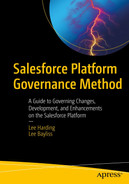Salesforce Platform Governance Method
A Guide to Governing Changes, Development, and Enhancements on the Salesforce Platform

This Apress imprint is published by the registered company APress Media, LLC part of Springer Nature.
The registered company address is: 1 New York Plaza, New York, NY 10004, U.S.A.
It takes more than the author(s) to write a book that tackles an IT subject area. Books are mainly about sharing your knowledge, which in turn is gained from the people you work with and those who influence you. It is these people who provide the balance of work and life and help you grow into the person you become. I would like to thank all those people who have helped me, taught me, influenced me, and challenged me on the path that has brought me to this moment.
—Lee Harding
Both of our careers have been spent entirely in the information technology arena, and we sometimes crossed paths as we worked on various projects in all manner of industries. We both arrived at Salesforce later in your overall entire careers you came across Salesforce and were PAs at that time. During our engagements as PAs, we noticed that companies were looking to implement the Salesforce platform without using the normal governance and controls that we would have expected from large IT projects, and it got us thinking as to why this was.
For some businesses, providing users access to the Salesforce platform as their customer relationship management (CRM) system was no different from providing Microsoft Office to users as their productivity suite. This led us to observe a number of instances in which the typical controls and governance that we would expect to see were just not there. This demonstrated to us that there was a gap in the understanding of not only the Salesforce platform, but also how important Salesforce has become as the cornerstone of so many successful businesses. It is fair to say that without the Salesforce platform, many businesses simply would not operate or be in a position to achieve the desired business outcomes demanded by customers in this modern age.
With our background in large IT project implementations and business transformations, we had always put governance and control at the forefront of the delivery process. Ultimately, we were delivering projects that would underpin a business going forward, so why wouldn’t they deserve rigorous control and adherence to standards with stakeholder participation and support?
One thing that makes the Salesforce platform unique is its diversity of use. Mark Beneoff raised this exact challenge during a conference discussion. The Salesforce platform is used by every size and type of business, from corner shops to multi-billion-dollar enterprises. Therefore, there was a need for a governance method that really covered the diversity of Salesforce’s platform implementations.
We are not suggesting that a corner shop needs a lot of governance and control, and it is quite possible that they could use the platform with little to no changes, but in our experience there are always changes made to the platform, and how these changes are managed and governed could ultimately dictate the impact that they have on a business and its success.
This led us to create the Salesforce Platform Governance Method. Our solution, designed over many years while working with numerous customers, helps companies to govern this platform that has such diverse usage. We have worked with all sizes and types of companies, and used the platform for all manner of reasons, in some cases moving away from the basic CRM concept.
Our governance method is designed to help everyone take the time to help themselves, to deliver changes on the platform and challenge themselves that those changes are as good as they can be. We are trying to help customers to reduce their technical debt, and to make technical decisions that aid the business while ensuring the solution does not become something they will later regret. This is by no means a simple task. The Salesforce platform is known for its ability to deliver rapid changes, which is an aspect Salesforce customers love. The declarative nature of the platform makes creating a change a simple process to execute. However, governance applies to all aspects of change; just because something is easy to implement does not mean you should do it without due care and attention—the premise of solution governance. This is the core message of this book: how to deliver change that enables the business to move forward and grow, while considering the concepts of good governance. The challenge was to come up with something that was as lightweight as we could make it, while covering the breadth of the Salesforce platform’s features.
We hope we have done something that you will find helpful in achieving a comfortable level of control over your Salesforce platform instance. We have tried to make the method something that you can pick from, like a menu in a restaurant, rather than your having to take everything offered.
We suspect that this book is the start rather than the final thing. The Salesforce platform does not stand still. With three releases each year, it is likely that features will come and features will go, and as such this governance method will ebb and flow. You should consider this a journey of change, as it has to be with a platform that constantly changes. Take what we have created and tailor it to your needs.
We wish you all success and hope you enjoy this book.
—Lee & Lee
First and foremost, there are no words that can express my gratitude to my wife and family, who were very patient and supportive while I worked throughout the evenings and weekends to complete this book. I am sure they are now grateful for the break, and perhaps know far more about governing the Salesforce platform than they ever wanted to know.
I am also very grateful to the team at Apress, especially Susan McDermott, whom Lee and I initially contacted about the idea of the book and who gave us the support and encouragement to make it happen. Also, to Shrikant Vishwakarma, who tirelessly checked in with us to make sure we knew what needed to be done and was patient and supportive when we were a little late. A big thank you to Laura Berendson for helping us get the book through its final stages.
I would like to extend a very warm thank you to Kal Chintala for his feedback and comments, which have helped improve this book from its original draft.
Last but by no means least, I would like to extend our gratitude to the Salesforce community and ecosystem that gave me the inspiration to write this book.
—Lee Harding
When Lee (Harding) approached me with the idea of writing a book, I was at first skeptical and unsure if this was something that I could commit to, or if I could support Lee in this process. However, we discussed the concept, and as we developed our ideas and discussed the approach to governance that we would take, I decided that this was something I just had to be involved in. I’m so pleased that I decided to embark on this unbelievable journey with him. For me, this has been a cathartic exercise of discovery, giving me the chance to work closely with a valued colleague, friend, and fellow technologist, which has been an enjoyable, and at times stressful, but ultimately a fantastic experience.
My family has been amazing: my wife, Claire, and my three children have been very supportive and encouraging throughout. However, my middle son was relieved once I could get back outside to play football with him after the writing and research were complete.
I would also like to thank the Apress team, with a special mention to Kal Chintala, Susan McDermott, and Shrikant Vishwakarma for their support and encouragement throughout this process. Kal’s thought-provoking and constructive comments were a source of inspiration and were always appreciated.
And finally, I would like to thank all the Salesforce trailblazers out there who work tirelessly to reimagine how to run their businesses on possibly the greatest cloud platform available in the marketplace. I sincerely hope that this book helps you to continue to realize success and to support your business process as you achieve limitless business outcomes.
—Lee Bayliss



